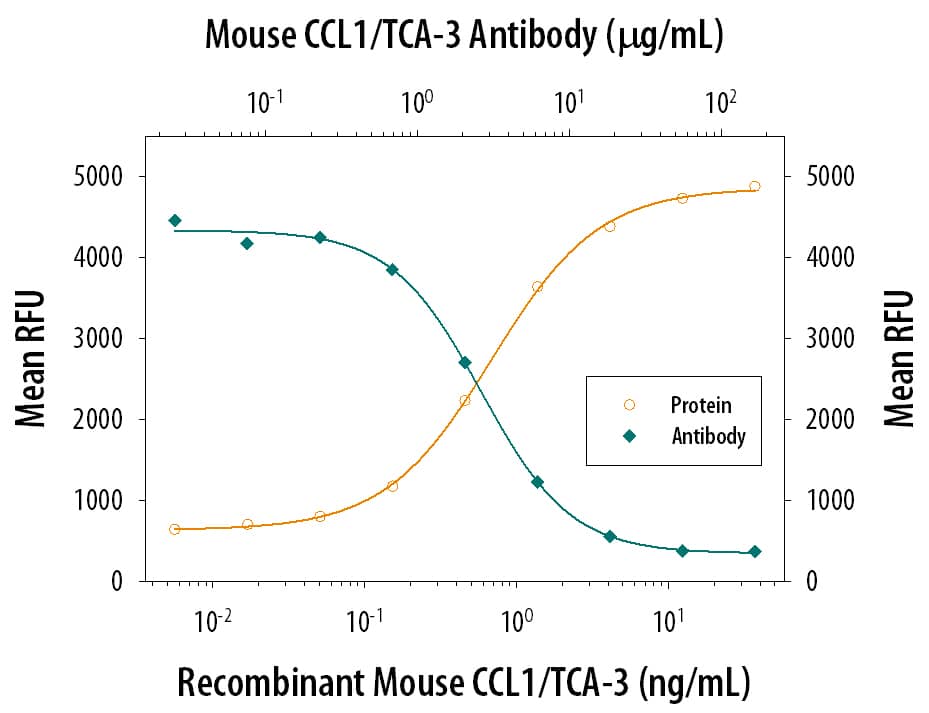Mouse CCL1/I-309/TCA-3 Antibody
R&D Systems, part of Bio-Techne | Catalog # MAB845

Key Product Details
Species Reactivity
Validated:
Cited:
Applications
Validated:
Cited:
Label
Antibody Source
Product Specifications
Immunogen
Lys24-Cys92
Accession # P10146
Specificity
Clonality
Host
Isotype
Endotoxin Level
Scientific Data Images for Mouse CCL1/I-309/TCA-3 Antibody
Chemotaxis Induced by CCL1/ITCA-3 and Neutralization by Mouse CCL1/ITCA-3 Antibody.
Recombinant Mouse CCL1/TCA-3 (Catalog # 845-TC) chemoattracts the BaF3 mouse pro-B cell line transfected with mouse CCR8 in a dose-dependent manner (orange line). The amount of cells that migrated through to the lower chemotaxis chamber was measured by Resazurin (Catalog # AR002). Chemotaxis elicited by Recombinant Mouse CCL1/TCA-3 (0.01 µg/mL) is neutralized (green line) by increasing concentrations of Mouse CCL1/TCA-3 Monoclonal Antibody (Catalog # MAB845). The ND50 is typically 2-10 µg/mL.Applications for Mouse CCL1/I-309/TCA-3 Antibody
Western Blot
Sample: Recombinant Mouse CCL1/I-309/TCA-3 (Catalog # 845-TC)
Neutralization
Formulation, Preparation, and Storage
Purification
Reconstitution
Formulation
Shipping
Stability & Storage
- 12 months from date of receipt, -20 to -70 °C as supplied.
- 1 month, 2 to 8 °C under sterile conditions after reconstitution.
- 6 months, -20 to -70 °C under sterile conditions after reconstitution.
Background: CCL1/I-309/TCA-3
Mouse CCL1, also known as TCA-3, is a member of the CC beta family of chemokines. The human chemokine I-309, which shares approximately 42% amino acid (aa) sequence identity, has been assumed to be the homologue of mouse TCA-3. Mouse TCA-3 and human I-309 also share significant sequence homology in the 5' flanking region of their genes and each contain an extra pair of cysteine residues not found in most other chemokines.
CCL1 cDNA encodes a 92 aa residue precursor protein with a predicted 23 aa signal peptide that is cleaved to produce a 69 aa mature protein. The sequence of CCL1 contains one potential N-linked glycosylation site. Mouse CCL1 is found on the distal portion of mouse chromosome 11 in a cluster with MIP-1 alpha, MIP-1 beta and JE. CCL1 acts by binding to the seven transmembrane spanning G-protein-coupled receptor, CCR8. CCL1 has been shown to chemoattract T cells.
References
- Goya, I. et al. (1998) J. Immunol. 160:1975.
- Burd, P. et al. (1987) J. Immunol. 139:3126.
Alternate Names
Gene Symbol
UniProt
Additional CCL1/I-309/TCA-3 Products
Product Documents for Mouse CCL1/I-309/TCA-3 Antibody
Product Specific Notices for Mouse CCL1/I-309/TCA-3 Antibody
For research use only
